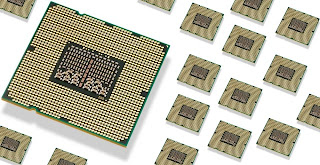Not the best of news to readers who were hoping for these sprinting chips to hit the market next year, but the news shouldn't be set aside because at the moment the implementation is theoretical. It could alter the way you use your devices.
A research team with members from University of Illinois & University of Pennsylvania has been inquiring in to the feasibility of what they call computational sprinting, a process by which existing chips could be made to operate at hugely increased speeds for short periods of time. They have come to the conclusion that that it is indeed feasible to engineer such a method.
Then there is the heat generated by these chips our laptops & desktops have lots of space for air to move, by comparison, & fans to usher hot air out & cold air in. Rings dont have those luxuries, so the amount of work they can do at any given time is limited. The transistors on the chips cant be active for long or they'll cause much heat & melt themselves or surrounding parts.
The processing & storage in our rings, usually in method on a chip form, have been gaining speed for the last few years, but there's a few physical restrictions that prevent them from working at full capacity. First there is the fact that speedy chips need lots of power, & battery know-how inst up to the task.
But the kinds of things that need a massive exertion from the processor are seldom sustained for long: converting the knowledge from a camera sensor to a JPEG, or unpacking a compressed file. The researchers asked themselves whether they could design a chip that could spin up to a much higher speed, but only for a limited time, as the heat generated would be, for the method, immense. The transistors involved would must rest afterward.
The implications are massive in the a position to bring a processor at full speed for only a second. Loading assets in to memory, reading and extracting files, tasks, which are often slow to start or operation of an app could be radiated by the phone and back to a standard state as soon as the heavy lifting has been done.
Their findings recommend that a chip sitting asleep with (in their implementation), 15 additional cores, but will be activated immediately available for a full second, move the unit to0 times its "resting" rate could be designed. The heat generated would be treated by non-traditional means, such as a phase-change heat sink.
The paper was made yesterday at a gathering in New Orleans, the researchers are Arun Raghavan and Milo Martin at Penn, with Thomas Wenisch, Marios Papaefthymiou, Kevin Pipe, Yixin Luo, and Anuj Chandawalla, from Texas.
Whether the researchers' model or another is to be used, the idea of a Dash Sound CPU. Others are the implementation of ideas that appear to parallel (so to speak) on this: multiple cores, special on-call and silicon arm is a little chip.
A research team with members from University of Illinois & University of Pennsylvania has been inquiring in to the feasibility of what they call computational sprinting, a process by which existing chips could be made to operate at hugely increased speeds for short periods of time. They have come to the conclusion that that it is indeed feasible to engineer such a method.
Then there is the heat generated by these chips our laptops & desktops have lots of space for air to move, by comparison, & fans to usher hot air out & cold air in. Rings dont have those luxuries, so the amount of work they can do at any given time is limited. The transistors on the chips cant be active for long or they'll cause much heat & melt themselves or surrounding parts.
The processing & storage in our rings, usually in method on a chip form, have been gaining speed for the last few years, but there's a few physical restrictions that prevent them from working at full capacity. First there is the fact that speedy chips need lots of power, & battery know-how inst up to the task.
But the kinds of things that need a massive exertion from the processor are seldom sustained for long: converting the knowledge from a camera sensor to a JPEG, or unpacking a compressed file. The researchers asked themselves whether they could design a chip that could spin up to a much higher speed, but only for a limited time, as the heat generated would be, for the method, immense. The transistors involved would must rest afterward.
The implications are massive in the a position to bring a processor at full speed for only a second. Loading assets in to memory, reading and extracting files, tasks, which are often slow to start or operation of an app could be radiated by the phone and back to a standard state as soon as the heavy lifting has been done.
Their findings recommend that a chip sitting asleep with (in their implementation), 15 additional cores, but will be activated immediately available for a full second, move the unit to0 times its "resting" rate could be designed. The heat generated would be treated by non-traditional means, such as a phase-change heat sink.
The paper was made yesterday at a gathering in New Orleans, the researchers are Arun Raghavan and Milo Martin at Penn, with Thomas Wenisch, Marios Papaefthymiou, Kevin Pipe, Yixin Luo, and Anuj Chandawalla, from Texas.
Whether the researchers' model or another is to be used, the idea of a Dash Sound CPU. Others are the implementation of ideas that appear to parallel (so to speak) on this: multiple cores, special on-call and silicon arm is a little chip.









0 comments:
Post a Comment